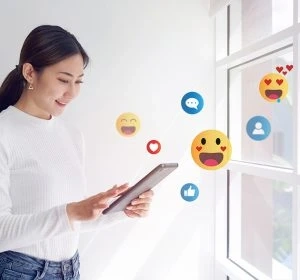In a world where digital communication has become an integral part of our daily lives, the use of emojis has taken center stage. These small, colorful characters have transformed the way we express our thoughts, emotions and ideas in the digital realm. In this blog post, we'll embark on a journey to explore the origins and evolution of emojis, and delve into their profound impact on the way we communicate and the development of a new language in the digital age.
Origins of Emojis
Emojis, the term itself a combination of "e" (for picture) and "moji" (for character), were first developed in Japan in the late 1990s. Shigetaka Kurita, an engineer at NTT DoCoMo, a Japanese mobile communication company, is credited with creating the first set of emojis. Kurita's initial motivation was to design simple, visual icons that could convey emotions and expressions more efficiently on early mobile phones with limited text capabilities.
You can read more about the Japanese culture here.
The first set of emojis included basic faces, weather symbols, and a variety of simple objects. They were initially intended for Japanese users, but quickly gained popularity and started to spread globally as mobile technology advanced.
Evolution of Emojis
The evolution of emojis has been remarkable. What began as a modest set of basic expressions has now expanded into a vast and diverse collection of over 3,000 emojis, each conveying a wide range of emotions, objects, and concepts. Major tech companies like Apple, Google, and Microsoft have played significant roles in standardizing and popularizing emojis across different platforms.
Emojis have evolved to include not only expressions of emotion, but also a wide array of symbols, food, animals, and objects. They have become more inclusive, featuring diverse skin tones, gender-neutral options, and cultural symbols to reflect the global nature of digital communication.
Impact on Language
Emojis have had a profound impact on language and communication in several ways:
Visual Expression: Emojis provide a visual dimension to text-based communication, allowing users to convey emotions and intentions more effectively. They fill the gap created by the lack of facial expressions and body language in digital conversations.
Universality: Emojis are a universal language that transcends linguistic and cultural barriers. People from different parts of the world can understand and use emojis to communicate, making them a powerful tool for global communication.
Emotional Nuance: Emojis allow you to subtly express emotions. A simple smiley face can convey happiness, while a wide range of emojis can express more complex feelings like love, frustration, or excitement.
Reducing Miscommunication: Emojis can help alleviate misunderstandings by adding context to messages. For example, a playful wink can make a potentially sarcastic message appear lighthearted.
Cultural Adaptation: Emojis have adapted to reflect a diversity of cultures and identities, making digital communication more inclusive and representative of the global population.
Integration in Business: Emojis are not limited to personal communication; they have also become a part of business and marketing strategies. Brands use emojis to connect with customers on social media and in advertising campaigns.
Emojis have come a long way since their inception in Japan, evolving from a set of basic expressions to a globally recognized and universal form of communication. Their impact on language is undeniable, enhancing our ability to express emotions, connect across borders, and add depth to digital conversations. As we continue to witness the ongoing evolution of emojis, it is clear that they have become an integral part of our digital language, enriching our daily interactions and shaping the way we communicate in the modern age.
sources blog:- https://thespanishgroup.org/blog/the-origins-and-evolution-of-emojis-and-their-impact-on-language/



